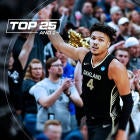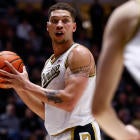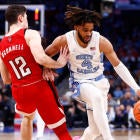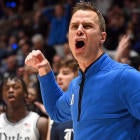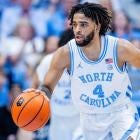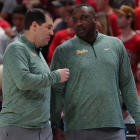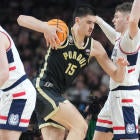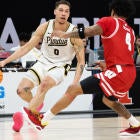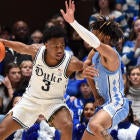The 2019-20 college basketball season will commence in a matter of weeks. Our All-America teams have been released, our preseason rankings -- all 353 of them, thanks to the diligent (and slightly crazy) Matt Norlander -- have been tallied. We've inundated you with plenty of goods to be armed with knowledge for the season.
And we're not done yet. Next comes arguably our most daunting task yet: ranking the top players. With roughly 15 players per roster and 353 teams to account for, that's around 5,000 players who were under consideration. We managed to whittle it down to a top 100 And 1.
In our list you'll see we've rummaged the college basketball spectrum to make sure only the best players -- regardless of classification or conference -- were included. We've got graduate transfers, one-and-done hopefuls and mid-major stars all included. And after our strenuous ranking process, we're ready to release our results.
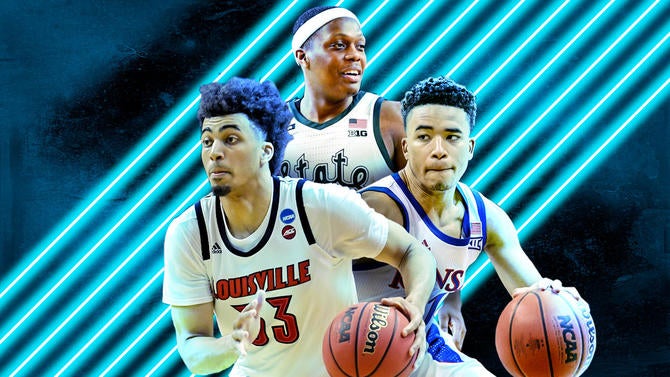
Top 100 And 1 college basketball players for 2019-20
1. Cassius Winston, Michigan State: Since Winston is the reigning Big Ten Player of the Year and the only CBS Sports First Team All-American to return to school, it's sensible for him to top this list. The 6-foot point guard averaged 18.8 points and 7.5 assists last season while shooting 39.8% from 3-point range. If Tom Izzo gets his second national title this season, Winston will be a big, and probably the biggest, reason why. — Gary Parrish
2. Myles Powell, Seton Hall: The Pirates have had some big talents in recent seasons (Isaiah Whitehead, Angel Delgado, Khadeen Carrington), but Powell's developed into the best of them all. He averaged 23.1 points, 4.0 rebounds and 2.9 assists last season for a 20-win Pirates team and now sets up as a national player of the year candidate in what could be the biggest season for the Hall in 25 years. The most impressive thing with Powell is how he's able to score and be dependable despite frequently facing double teams. — Matt Norlander
3. Markus Howard, Marquette: When Howard gets going, nobody in college basketball is more fun to watch. The 5-11 guard averaged 25.0 points, 4.0 rebounds and 3.9 assists last season while shooting 40.3% from 3-point range. He scored a career-high and Big East-record 53 points in a January victory over Creighton — and eclipsed the 35-point barrier six times in 34 games. And now Howard has a chance to shoot Marquette to the NCAA Tournament for the third time in a four-year career. — GP
4. Cole Anthony, North Carolina: Our highest-ranked freshman, Anthony steps into an envious situation. UNC has no long-range threat, except for Anthony. It has no primary ball-handler, except for Anthony. It probably has no alpha scorer, except for Anthony. It has no shot at making a Final Four, except for Anthony. It remains to be seen if the projected top-10 2020 NBA pick can be the kind of difference-maker in college that he's expected to be, but we've rated him so high based on seeing him in person at the prep level and combined that with knowing how much Roy Williams is likely to lean on a freshman guard as much as he ever has in his career. — MN
5. Kerry Blackshear Jr., Florida: The biggest prize on the graduate-transfer market, Blackshear was a huge get for the Gators. It's a development that made Florida a real challenger to Kentucky at the top of the SEC and, on paper, a Final Four contender. The 6-10 forward averaged 14.9 points and 7.5 rebounds last season while helping Virginia Tech make the NCAA Tournament for the third consecutive year. He will be the centerpiece of what should be Mike White's best team to date. — GP
6. Jordan Nwora, Louisville: Lofty praise for the preseason ACC Player of the Year, who averaged 17.0 points and 7.6 rebounds last season. He's the highest-rated player returning to the conference, and given how big a boost he had from freshman to sophomore year, if he can grow all the more as a junior, he'll have Louisville contending for an ACC title. — MN
Last year: All-ACC Third Team & Most Improved Player
— ACC Digital Network (@theACCDN) October 17, 2019
This Year: First Team All-American, First Team All-ACC, ACC Pre-Season Player of the Year@JordanNwora returns & the recognition is DESERVED💪🏆#GoCards | @LouisvilleMBB pic.twitter.com/IbQF9FPued
7. James Wiseman, Memphis: Wiseman rejected offers from blue bloods, most notably Kentucky, to play for his high school coach, Penny Hardaway, at Memphis. It was hardly a surprise but still something that qualified as a significant development, if only because a first-year college coach had never previously secured a commitment from the nation's No. 1 prospect. Whether Wiseman will be as awesome as recent elite bigs like Deandre Ayton and Marvin Bagley is up for debate. But there's little doubt he should lead Memphis back to the NCAA Tournament for the first time since 2014. — GP
8. Devon Dotson, Kansas: Look for Dotson, maybe now the fastest point guard in college hoops, to shine thanks to Kansas likely going back to relying on more big men in its rotation. If that's going to be the case, Dotson should be free to blitz and roam and wreak havoc on opposing defenses, be it in man or zone. He thrives almost no matter the scheme. After a formidable freshman season (12.3 ppg, 3.7 rpg, 3.5 apg), Dotson will likely compete with teammate Udoka Azubuike for first team All-America honors, should Kansas get a No. 1 seed. And I think it will. — MN
9. Tre Jones, Duke: Not many legitimate NBA prospects surprised folks by announcing a return to college — but Jones probably did. Most assumed he'd join teammates Zion Williamson, RJ Barrett and Cam Reddish as one-and-done Duke stars. But the 6-2 point guard instead decided to spent at least one more year at Duke, where he'll have a chance to help the Blue Devils secure a No. 1 seed in the NCAA Tournament for the second straight season. — GP
10. Jarron Cumberland, Cincinnati: Bulky shooting guard who has soft touch and doesn't rattle. Could it be that Cincinnati is set up to be the best team in the AAC? Oh, it just might. But if that's to happen, Cumberland will need to jump from 18.8 points per game to north of 23. And he'll need to increase his efficiency, which we think will happen under new coach John Brannen, who's more offensively inclined than Mick Cronin. If UC wins 25-plus games, Cumberland's a dark horse player of the year candidate. — MN
11. Ayo Dosunmu, Illinois: A sophomore star-turn is in line for Dosunmu. After a stellar freshman season with the Illini, he put the NBA — and a potential first-round slot — on hold to build his case to be a lottery pick. A 6-5 point guard with natural scoring instincts, he enters this season as one of the most exciting players in the Big Ten. — Kyle Boone
12. Anthony Edwards, Georgia: Georgia's top-10 recruiting class is good, but Edwards, the five-star headliner, is great. He was the No. 2 player in the 2019 recruiting class according to 247Sports and No. 1 at his position. That makes him the highest-rated signee in UGA basketball's history. — KB
13. Udoka Azubuike, Kansas: When Azubuike is at full strength, he's been the most dominant big man in the Big 12. But only once in his three seasons at KU has he played in more than 12 games. If he can avoid the injury bug, he'll be amongst the best players in the Big 12 and an anchor for a quality Jayhawks team. — KB
14. Isaiah Stewart, Washington: The Huskies' 11th-ranked recruiting class has two five-star freshmen headliners, and Stewart is the big prize. He was the No. 3 overall player in the 2019 class and the highest-rated signee in UW history. He'll bring energy and rebounding — emphasis on the rebounding — to a quality Huskies team loaded with young talent. — KB
15. Tyrese Haliburton, Iowa State: The Cyclones lost four of their top five scorers from a season ago, including guards Lindell Wigginton and Nick Weiler-Babb. Now it reloads with Haliburton, a sophomore who starred in a secondary role last season. He led all NCAA underclassmen in assist/turnover ratio last season while shooting 43.4% from 3-point range. — KB
Tyrese Haliburton made a believer out of me with his play in Crete at the U19 Worlds. 48 AST to just 8 TOVs in 175 MIN while shooting 12-of-14 from 2 and 10-of-18 from 3. Was all over the place defensively. Unorthodox game but positional size, shooting touch and tremendous feel. pic.twitter.com/8FzqE4EEbB
— Mike Schmitz (@Mike_Schmitz) July 8, 2019
16. McKinley Wright IV: This is one tough cat. Wright suffered a torn labrum last December and still managed to maneuver the rest of the Pac-12 slate with the bum shoulder, waiting until April to fix it with surgery. Now that he's healed up he's going to be expected to shoulder big expectations as the Buffaloes look to win the Pac-12 for the first time ever. — KB
17. Killian Tillie, Gonzaga: He's Gonzaga's best player if he can stay healthy. Only problem is, health is a legitimate concern. He missed more than half of last season nursing a foot injury, and he's already undergone surgery this fall on his knee. If he's able to rid the injury bug all season, No. 17 on this list will wind up being too low for him. — KB
18. Yoeli Childs, BYU: Childs needlessly had the first 10 games of his senior season taken away from him by the NCAA due to a paperwork bungle related to the NBA Draft declaration process. Despite this, we still like Childs as a potential All-American. He averaged 21.2 points and 9.7 rebounds last season and can improve on those stats under new BYU coach Mark Pope. — MN
19. Tristan Clark, Baylor: This power forward is probably the most undervalued player in our top 20. Terrific centerpiece for the Bears. Clark only played 14 games last season due to injury. If he's at full form for all of 2019-20, the Bears have enough around him to compete for second in the Big 12. — MN
20. Tyrese Maxey, Kentucky: For the first time in his tenure, John Calipari doesn't have a player on his roster who clearly and obviously sets up as one of the 15 best in college hoops heading into the season. But come March? Maxey could easily be that guy. He should be the locking piece to fill out a great backcourt attack for the second-ranked Wildcats. — MN
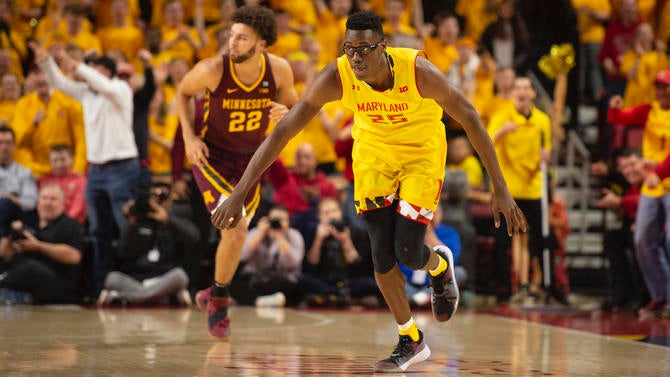
21. Jalen Smith, Maryland: As a freshman last season, Smith was part of a two-man towering frontcourt featuring Bruno Fernando. With Fernando now in the NBA, Smith will be the featured big — and on a preseason top-five team. His shot-blocking and rim-running add to the profile of an NBA-ready big primed to dominate the Big Ten. — KB
22. Jaden McDaniels, Washington: One of only seven five-stars to ever sign with Washington, McDaniels, a Washington native, has the tools to be a hometown hero. With a long, wiry frame and a skill set that projects to be problematic for Pac-12 foes, he should flash NBA talent right away with his unique and versatile game. — KB
23. Sam Merrill, Utah State: Merrill is the leading returning scorer in the Mountain West, but that's only the partial impact he's made on Utah State. As a junior last season he finished top 5 in the conference in free-throw percentage, assist rate, offensive rating and percentage of minutes played, per KenPom. He's the reigning MWC Player of the Year and the frontrunner to repeat. — KB
24. Lamar Stevens, Penn State: After a breakout All-Big Ten season last year, Stevens shoulders arguably the biggest load of any returning player within the league. The 6-8 forward is a multi-positional workhorse who led the conference in minutes played last season. — KB
Lamar Stevens set for a monster season! @LamarStevens11 pic.twitter.com/mOiqfuKLit
— Courtside Films (@CourtsideFilms) October 15, 2019
25. Kaleb Wesson, Ohio State: The impact of Wesson was felt for Ohio State last season when he was suspended three games and the Buckeyes promptly reeled off three consecutive losses. With him in the lineup, they went 20-13. His return alone vaults them back into the NCAA Tournament discussion. — KB
26. Xavier Tillman, Michigan State: Tillman is among the reasons Michigan State is the preseason No. 1 even after Nick Ward decided to leave school with one year of eligibility remaining. The 6-8 forward averaged 10.0 points, 7.3 rebounds and 1.7 blocks in 24.1 minutes per game last season while helping the Spartans make the Final Four. He averaged 13.3 points, 8.1 rebounds and 1.8 blocks in Michigan State's final 13 games. So a breakthrough season that culminates with all-league honors seems like a likely scenario. — GP
27. Nico Mannion, Arizona: The entire starting lineup leaving for the NBA Draft, combined with an FBI investigation that hurt the 2018 recruiting class, led to Arizona missing the NCAA Tournament last season for the first time since 2012. But the Wildcats should bounce back this season thanks to the enrollment of a top-10 recruiting class headlined by Mannion. The 6-3 point guard is a gifted playmaker and reliable shooter. He should be Arizona's next one-and-done stud. — GP
Nico mannion is a problem
— Evan Turner (@thekidet) April 13, 2019
28. Anthony Cowan, Maryland: Cowan might never be the make-everybody-better point guard some Maryland fans desire. But it should be noted that he has a realistic chance to become just the seventh 2,000-point scorer in program history — not to mention the key to Maryland maybe making the Elite Eight for the first time since 2002. — GP
29. Ashton Hagans, Kentucky: Hagans was an absolute difference-maker on the defensive end as a freshman — constantly pressuring and deflecting to the tune of 1.6 steals in 28.5 minutes per game. His decision to return to Kentucky provides John Calipari with some rare but needed experience in the backcourt. Hagans is good enough to help the Wildcats win an SEC regular-season title for the fourth time in a six-year period. — GP
30. Reggie Perry, Mississippi State: Perry averaged 9.7 points and 7.2 rebounds in 23.9 minutes per game as a freshman, then took a jump this summer by earning Most Valuable Player honors at the FIBA U19 World Cup. He's a 6-10 forward who should help Mississippi State make the NCAA Tournament for the second straight season while competing for All-America honors. — GP
31. Tres Tinkle, Oregon State: The Beavers enter the season as an NCAA Tournament longshot (ranked 78th in the CBS Sports 1-353) but does have, maybe, the best player in the Pac-12. Tinkle will probably wind up ranking top 30 in college hoops in minutes played because he's necessary to the Beavers' needs on both ends. Put up 20.8 points, 8.1 rebounds and 3.8 assists last season. — MN
32. Kamar Baldwin, Butler: The Bulldogs are going to face an uphill climb most of the season, but Baldwin could be good enough to make the critics (like us!) eat our words. Can he upgrade from 17.0 points, 4.9 rebounds and 3.1 assists? Butler lost a lot of its talent but it didn't lose Baldwin, who sets up as the most valuable guy to his team in the Big East. — MN
Kamar Baldwin (@kamar3baldwin) earned All-BIG EAST Second Team honors after averaging 17.0 PTS, 4.9 REB, 3.1 AST in his junior season at @ButlerMBB
— #BIGEASThoops (@BIGEASTMBB) May 3, 2019
📽️ #BIGEASThoops Full Season Highlights: pic.twitter.com/GnmKKVAA1u
33. Andrew Nembhard, Florida: A great example of how you can get a very good college player and not need to average double digits in scoring. Nembhard showed a lot of promise in his freshman season (8.0 ppg, 5.4 apg), but 2019-20 is his coming-out party. The Gators have an array of scoring options and all-around talent to surround Nembard, who I think could put up the most effortless triple-double we'll see this season. A 6-5, he's an unshakeable mismatch at point guard. — MN
34. Kira Lewis, Alabama: The Crimson Tide sophomore is this year's player most likely to have a Ja Morant-esque pop. He's young — still only 18, despite being a sophomore — and averaged 13.5 points, but since Alabama wasn't nationally relevant, most don't know of Lewis. He should shine for a Crimson Tide team that I expect to make it into the field of 68. If he's largely responsible for a resurgence, he'll be a lottery pick. — MN
6-3, 162 lbs + 18-year-old #Alabama sophomore PG Kira Lewis, who is younger than many incoming #NCAA freshmen, ticks some #NBA boxes with his shooting + feel@DraftExpress + @Mike_Schmitz on the top 2020 #nbadraft prospects from the 2019 @fiba U19 WC >> https://t.co/9ZMZLYgzgp pic.twitter.com/L264dNd0Cp
— DraftExpressContent (@DXContent) July 17, 2019
35. Anthony Lamb, Vermont: Catamounts coach John Becker told me Lamb's upgraded his diet, shed the fat and turned himself into the kind of player that should get viable looks at the NBA level come next April. He's got a good case as the best and most productive player from a low- or mid-major conference. Vermont's looking to make a third NCAA Tournament in the past four years, all of them with Lamb (21.2 ppg, 7.8 rpg, 1.9 bpg) featured prominently. — MN
36. Jordan Ford, Saint Mary's: Got a chance to watch Jordan Ford in person at the NCAA Tournament last season. He's a joy — and a blur. Plays like he's coated in grease. Truly, Saint Mary's has one of the most devious decision-makers in college hoops. He can turn on a twig and makes for a scouting headache. Can't wait to watch how he gets better this season. — MN
37. Payton Pritchard, Oregon: The Ducks have talent yet again, but Pritchard's (12.9 ppg, 4.6 apg) the one with the steady hand and is a guy who has grown into a top-10 point guard in college basketball. One out of every four Oregon baskets were via one of his assists when he was on the floor last season. If he can update to a reliable 3-point threat, he'll be a top-25 player in the sport. — MN
38. Jon Axel Gudmundsson, Davidson: The reigning Atlantic 10 Player of the Year might not have the pro potential of his teammate, Kellan Grady, but he's at this point established himself as the slightly better college player. Gudmundsson put up 16.9 points, 7.3 rebounds and 4.8 assists in 2018-19. Now he's teamed up again with Grady on what could amount to a top-three Davidson team in program history. — MN
39. Alpha Diallo, Providence: The Friars are my sleeper pick to win the Big East. Diallo is the best PC player on a roster filled with top 150-type players. Truth is, we could come to find we ranked him 20 spots too low. Last season, the 6-7 small forward averaged 16.0 points, 8.1 rebounds, 3.1 assists, 1.6 steals. Fifty-four percent of his shots were foul shots, which ranked top-100 in college hoops. — MN
Alpha Diallo averaged 16 points, 8 rebounds, and 3 assists a junior. See his full junior season highlights here: https://t.co/WuWKQLl0Gc #pcbb pic.twitter.com/84YaKgCh4E
— Kevin Farrahar (@Kevin_Farrahar) October 23, 2019
40. Naji Marshall, Xavier: The best player on what should be a vastly improved X squad that has rightful expectations to get back to its usual spot: the NCAA Tournament. Marshall's (14.7 ppg, 7.2 rpg) performances can act as a windsock for Xavier. Strong, healthy, a savage in the paint when undersized forwards find themselves caught in a mismatch. — MN
41. A.J. Lawson, South Carolina: Fun-to-watch wing who put up 13.4 points, 4.3 rebounds and 2.9 assists last season, his first in college basketball. You might need to work a bit find him this season because South Carolina is not expected to be an NCAA Tournament team. — MN
42. Vernon Carey Jr., Duke: Hard to gauge Carey's impact right away for Duke. The Blue Devils have, for the past decade, largely just relied on two players for creating or sustaining offense. It doesn't seem like that will be the case this season, but if it is, might Carey's dominant size and power around the rim be a change of pace for Mike Krzyzewski? His ceiling feels like top 10 as a player, nationally, and his floor in the 70s. So we're splitting it down the middle. — MN
43. Scottie Lewis, Florida: If Lewis shows us that he has a jump shot by the time Christmas arrives, he's going to be a top-20 player in America. The only significant hole in his game is shot creation and long-range ability. Everything else he's got in his toolbox. Will be a one-and-done. — MN
44. Obi Toppin, Dayton: Kostas Antetokounmpo, in 2018, was Dayton's first NBA pick in 28 years. Next June, Toppin might become the second Flyer in three seasons to get picked. The 6-9 sophomore is a hidden gem who will break out nationally if UD winds up positioning itself for an NCAA Tournament bid. Averaging 20 and 10 is plausible for Toppin, who may well start to step out and expand his game near the arc. — MN
Went through last year's NIT matchup of Obi Toppin vs Tyler Bey
— Jonathan Wasserman (@NBADraftWass) October 22, 2019
Colorado, Bey (11 & 10) got the W but Toppin (21 pts, 2 3PT) was a standout with his power, bounce, coordination and touch. First-round prospect for 2020. pic.twitter.com/uqAav4unim
45. Skylar Mays, LSU: Overshadowed a bit last season by Tremont Waters and Naz Reid. Know this: there aren't 10 more mature, respected players on this list than Mays, whose story we detailed in part last season. The LSU senior lost his longtime friend and teammate, Wayde Sims, to pointless gun violence. Now Mays should become an efficient shooting guard who can facilitate and keep LSU's offense multi-dimensional. — MN
46. Desmond Bane, TCU: After a second-team All-Conference campaign, he leads TCU's charge to do what it hasn't since the 1950s: to make it to the NCAA Tournament twice in a span of three seasons. Bane led all Big 12 players in minutes played last season as a junior and led TCU in scoring and 3-point percentage. — KB
47. Kellan Grady, Davidson: The ticker continues to trend upwards for Grady. He was A-10 Rookie of the Year as a freshman, an A-10 First Team performer as a sophomore, and as a junior, he figures to be one of the best in the league … again. He's the third-leading returning scorer in the conference behind only Richmond's Grant Golden and teammate Jon Axel Gudmundsson. — KB
48. Markell Johnson, NC State: After leading the ACC in assists as a sophomore, Johnson took on a bigger role as a go-to scorer for NC State as a junior. And now with more talent surrounding him, the expectation is that the sophomore and junior versions of himself meld into one of the most productive players in the conference. — KB
49. Neemias Queta, Utah State: As a freshman, Queta finished first in the MWC in shots blocked and fourth in rebounding. As a sophomore he'll anchor a rising Utah State team that is looking to repeat as NCAA Tournament participators, which the program hasn't done since 2011. — KB
PORTER ✈️ QUETA#AggiesAllTheWay pic.twitter.com/QQ6gZMVEKG
— USU Men's Hoops (@USUBasketball) March 16, 2019
50. Mustapha Heron, St. John's: In his first season at St. John's following his transfer from Auburn, Heron acquitted himself nicely as a co-star to Shamorie Ponds. But now it's Heron's time to shine. Under a new coaching regime, he should operate as the new No. 1 option in the Red Storm's new system. — KB
51. Ty-shon Alexander, Creighton: Alexander started 34 games last season and led Creighton in points, 3-pointers and steals while helping the Bluejays make the quarterfinals of the NIT. The 6-4 guard averaged 15.7 points as a sophomore, which was 10.2 more points per game than he averaged as a freshman. That year-over-year scoring improvement was the best in the Big East. — GP
52. Lamonte Turner, Tennessee: Turner is the leading returning scorer from a Tennessee team that finished 31-6 last season and advanced to the Sweet 16 of the NCAA Tournament. The 6-2 senior averaged 11.0 points, 3.8 assists and 2.8 rebounds in 31.0 minutes per game. He got a season-high 24 points against Auburn in the title game of the SEC Tournament. — GP
53. Breein Tyree, Ole Miss: The only First Team All-SEC player who returned to school, the 6-2 senior averaged 17.9 points while making 37.5% of the 5.6 3-pointers he attempted per game last season. He has a chance to lead Ole Miss to consecutive NCAA Tournament appearances for the first time since the Rebels made it 2001 and 2002. — GP
54. Antoine Davis, Detroit: Davis averaged 26.1 points per game as a freshman, which ranked third nationally and makes him college basketball's leading returning scorer this season. The 6-1 guard sank 132 3-pointers to break the sport's record for 3-pointers made by a freshman that was set by Stephen Curry in 2007. Davis had at least 17 points in all 30 Detroit games last season. — GP
In case you are wondering why Antoine Davis earned #HLMBB Preseason Player of the Year and is a candidate for the #WestAward #DetroitsCollegeTeam pic.twitter.com/ViuCLA5Lhn
— Detroit Mercy MBB (@DetroitMBB) October 16, 2019
55. Matthew Hurt, Duke: One of two 5-star freshmen in Duke's latest great recruiting class, the 6-9 forward averaged 37.4 points and 12.4 rebounds as a senior at John Marshall High in Minnesota and finished his prep career with 3,550 points and 1,451 rebounds. He helped USA Basketball win a gold medal at the 2018 FIBA Americas U18 Championship in Canada. — GP
56. Javonte Smart, LSU: Smart averaged 11.1 points and 2.4 assists per game last season as a freshman. His numbers should increase across the board as he replaces All-SEC First Team point guard Tremont Waters. — KB
57. Mamadi Diakite, Virginia: After a heart-to-heart midseason conversation with coach Tony Bennett, Diakite invigorated Virginia in its title run by earning a spot on the starting lineup. He's a tremendous shot-blocker ready to turn a corner as a more consistent scorer on a team that lost its top three scorers. — KB
58. Charles Bassey, Western Kentucky: As a true freshman last season with the Hilltoppers, Bassey finished second in Conference USA in shots blocked and in rebounds. Most expected the former five-star recruit to declare for the draft and leave. Instead, he declared, got feedback, and chose to come back to school, instantly making him one of the best returning big man talents in C-USA. — KB
59. Tyler Bey, Colorado: With teammate McKinley Wright IV nursing a shoulder injury for most of Pac-12 play, Bey emerged as one of the best talents in the league, averaging 13.6 points and a whopping 9.9 rebounds per game. Among Pac-12 players, he ranked top 10 in usage, offensive and defensive rebounding percentage, and fouls drawn per 40 minutes, according to KenPom.com. — KB
60. Zavier Simpson, Michigan: The hook shot is cool again in college basketball thanks to Simpson, the unquestioned king of the old-school shot. He's not a flashy player, but he's a defensive menace who can run the offense at a high level and make smart decisions, as evidenced by his top-10 national ranking in assist/turnover ratio. — KB
61. Matt Haarms, Purdue: The 7-3 junior should be Purdue's best player if he can become the latest example of a big overhauling his game and instincts under Matt Painter. Haarms (9.4 ppg, 5.4 rpg, 2.1 bpg) is ranked highly because of his defensive progression and his burgeoning step-out game. Plus, you know, we can't say the hair wasn't a factor. — MN
62. Precious Achiuwa, Memphis: Recognized as the second best player on Memphis' seriously talented roster. Achiuwa was the 15th-ranked player in the Class of 2019, per 247 Sports' Composite. The power wing should benefit from James Wiseman facing double teams, not to mention the Tigers' backcourt being shifty enough to free up his talents for big-play opportunities. — MN
63. Lamine Diane, CS Northridge: Avid readers of the Frosh Watch know this guy and what he did as a freshman last season. Diane smashed Big West freshman records on his way to averaging 24.8 points and 11.2 rebounds. He also had 2.2 blocks and 1.5 steals per game. And 2.1 assists. In short, no one in college hoops last season matched his stat line. Now, if he can be efficient? Then he's a top-30 player. — MN
Lamine Diane made history by becoming the first player ever to win Big West Player of the Year, Newcomer of the Year and Freshman of the Year awards all in the same season. Terrell Gomez earned his first career All-Big West First Team honor alongside running mate Diane. pic.twitter.com/ZgrO1eXLwo
— CSUN Matadors (@GoMatadors) March 11, 2019
64. Joe Wieskamp, Iowa: Averaged 11.1 points and 4.9 rebounds for a 23-12 Iowa team. The Hawkeyes don't look to be as good this season as last, but Wieskamp should capitalize as the go-to scorer because Jordan Bohannnon will miss the 2019-20 campaign. If the double teams don't get to him, should shoot north of 40% from 3 again. — MN
65. James Akinjo, Georgetown: He's about 10 spots too low for my tastes here, but I'm glad Georgetown's got a guard back in the mix for one of the best in the Big East. Akinjo (13.4 ppg, 5.2 apg) is not an elite point guard, but it's his daringness and his unpredictability between shooting and driving that make him an ideally fun college basketball backcourt dynamo. — MN
66. Jon Teske, Michigan: A throwback big with a sprinkle of some modern-day skills. Teske's rock solid around the rim on both ends and has the mobility to switch into defending the perimeter. Under new coach Juwan Howard, he could get an uptick in touches given how much production the team lost in the offseason. — KB
67. John Mooney, Notre Dame: It was a breakout season for Mooney in 2018-19 when he led the team in scoring and the ACC in rebounding. But alas, last season turned out to be Notre Dame's worst season ever under coach Mike Brey. Bank on the Irish to break out of that funk and for Mooney to be the biggest reason why. — KB
68. Grant Riller, Charleston: Charleston's been to the NCAA Tournament five times in its program's history. Only one of those appearances came this century. Because of Riller, there's hope for a second in three seasons. A flashy do-it-all guard, he led the team in scoring a season ago and is the top returning scorer in the CAA this season. — KB
Grant Riller is good at basketball.
— Mitch Pugh📰 (@SCMitchP) December 15, 2018
69. Jalen Pickett, Siena: As a freshman Pickett led the MAAC in assists while rating out in the top 10 in the conference in blocks, points and steals and minutes played. He tested the NBA Draft in the offseason but ultimately chose to return, making Siena a fascinating sleeper to win the league. — KB
70. Josh Green, Arizona: An Australian native who only recently came to the states to better prepare himself for his basketball future — which appears to be the NBA — Green has great size, athleticism and shooting that pads Arizona's stacked (and young) roster. — KB
71. Bryce Aiken, Harvard: Aiken has averaged at least 14.1 points in three straight seasons — among them last season when the 6-0 guard averaged 22.2 points in 32.8 minutes per game while shooting 39.8% from the 3-point arc and earning First Team All-Ivy honors. He should have the Crimson back in the NCAA Tournament this season for the first time since 2015. — GP
72. Davide Moretti, Texas Tech: The Red Raiders advanced all the way to the title game of the NCAA Tournament and Moretti was a big reason why. The 6-3 guard averaged 11.5 points in 31.6 minutes per game and shot 45.9% from 3-point range and 92.4% from the free-throw line — the latter of which was the best free throw percentage in the nation. — GP
73. Josh Langford, Michigan State: A foot injury limited Langford to just 13 appearances last season because of a foot injury — but he was averaging 15.0 points in 28.6 minutes per game before being sidelined in late December. Put another way, Michigan State lost its second-leading scorer midseason and still won the Big Ten regular-season title, Big Ten Tournament title and advanced to the Final Four. Langford's foot injury will keep him out until at least January, but his possible return is one the reasons Michigan State is the favorite to win the NCAA Tournament. — GP
74. Omer Yurtseven, Georgetown: Before transferring to Georgetown, Yurtseven averaged 13.5 points and 6.7 rebounds in 23.8 minutes per game two seasons ago at NC State. He sat out last season per normal NCAA transfer rules but is eligible now and expected to be a key member of a Georgetown team that should make the NCAA Tournament for the first time under Patrick Ewing. — GP
75. Xavier Johnson, Pittsburgh: The 6-1 guard wasn't the most heralded freshman on Pitt's roster last season — but he was the most productive. Johnson averaged 15.5 points, 4.5 assists and 3.9 rebounds in 31.8 minutes per game for a Pitt team that beat Florida State and Louisville. He's the main reason the Panthers jumped 126 spots at KenPom from their last season under Kevin Stallings to their first season under Jeff Capel — GP
76. Trent Forrest, Florida State: The 6-4 guard enters his senior year already in the top 10 of Florida State's career steals list. Forrest averaged 9.3 points, 4.5 rebounds, 3.7 assists and 1.9 steals in 29.9 minutes per game last season. He's a big reason why the Seminoles have advanced in three straight NCAA Tournaments and been within a game of what would've been FSU's second trip to the Final Four. — GP
77. Trendon Watford, LSU: The prize of Will Wade's latest nice recruiting class at LSU, the 6-9 forward is a 5-star prospect who led Mountain Brook High in Alabama to three consecutive state championships. He averaged 23.7 points, 11.8 rebounds, 3.6 assists and 2.5 blocks as a senior while securing an invitation to the McDonald's All-American Game. — GP
78. Kahlil Whitney, Kentucky: One of three 5-star prospects in Kentucky's heralded recruiting class, the 6-6 wing scored 38 points in the Iverson Roundball Classic All-Star Game and earned co-MVP honors. He scored more than 2,000 points in his four-year career at Roselle Catholic High in New Jersey and averaged 21.1 points and 7.2 rebounds during his senior season. — GP
Not 1 … Not 2 … @KentuckyMBB’s Kahlil Whitney jumped over 3 people 😱 pic.twitter.com/rMVJ5NYfEr
— SEC Network (@SECNetwork) October 12, 2019
79. Derek Culver, West Virginia: A borderline top-85 prospect in high school, Culver averaged 11.5 points and 9.9 rebounds in 27.0 minutes per game as a freshman to earn Big 12 All-Freshman Team honors. The 6-10 forward had an offensive-rebound rate and defensive-rebound rate that both ranked in the top 50 nationally. He had eight double-doubles in league games. That's more than any other returning player in the Big 12. — GP
80. Isaiah Joe, Arkansas: The 6-5 guard set Arkansas' record for 3-pointers attempted and made in a season last season when he took 273 and made 113. That means Joe made 41.4% of the 8.0 attempts he took per game. He was one of only seven players in Division I basketball to make at least 110 3-pointers while shooting at least 41.0% from the arc. — GP
81. Jordan Bowden, Tennessee: A 6-5 wing, Bowden (10.6 ppg, 3.5 rpg) has a good chance to lead a still-talented Tennessee team in scoring. The Volunteers won't be as good as last season but could be nearly as fun to watch if Bowden's potential is helped to an unlocking via Lamonte Turner. Heck, he could make us look dumb and turn into a top-40 player by March. — MN
82. Nojel Eastern, Purdue: Weird how it landed this way, but the next two players are Boilermakers. Might we be too low on the fun, rangy combo guard? We'll see. Great defender, good instincts, but still needs some work on his shooting. Matt Painter's got a way of fixing that with many of his players. No Carsen Edwards anymore, so shots aplenty to share. — MN
83. Trevion Williams, Purdue: The next two players on our list are the unusual instances of guys with low averages who nonetheless overcame their production to break through into the 101. Williams (5.2 ppg, 4.0 rpg) will move from bench player to pivotal power man for a revamped, but still well-stocked, Purdue crew. — MN
84. Jay Huff, Virginia: One of the most enticing breakout candidates in college basketball. Huff will step in and be asked to replace a lot of the offensive production lost from last season in Charlottesville. The 7-1 Huff only averaged 4.4 points and 2.1 rebounds, but there's no reason those numbers shouldn't triple — minimally. — MN
85. C.J. Elleby, Washington State: A wonderful bright spot on what's likely to be a bad team again, Elleby averaged 14.7 points, 7.1 rebounds and 3.0 assists for the Cougars last season. He's one of the few multi-faceted small forwards at the college level who can play and defend four positions. — MN
86. Xavier Sneed, Kansas State: Last season Sneed rated in the top 25 of the Big 12 in minutes played, turnover rate, steal percentage, 3-point percentage, true shooting percentage, block percentage and rebounding percentage. He'll enter the season as K-State's true No. 1 option after the top three scorers from last year's team moved on. — KB
"If not the best in the league, he's definitely up there, and I'm talking about in the country, and in some ways he's better than Barry (Brown)" - Bruce Weber on Xavier Sneed's defense.#KStateMBB pic.twitter.com/CLUARg2Am2
— Pete Francis (@Pete_Francis) October 16, 2019
87. Josiah-Jordan James, Tennessee: After a historically great 31-win campaign, Tennessee is on its way to handing the keys to the kingdom over to James, a freshman combo guard. The McDonald's All-American is the fourth-highest rated Vols signee ever. His positional versatility to play either guard spot should make him a seamless fit alongside veteran Lamonte Turner. — KB
88. Samuell Williamson, Louisville: Louisville already had a strong returning nucleus from last season, but the addition of a long wing with Williamson's skill set boosts the Cards up a notch. He's a tough player with a competitive edge who gives Chris Mack's team length and shot-making. — KB
89. Nathan Knight, William & Mary: The top returning rebounder in the CAA and second-leading returning scorer, Knight's nearing a pace to average a double-double this season. And with teammate Justin Pierce moving on to UNC, he's slated to take on a bigger role as the focal point of William & Mary's plans. — KB
💪 In good company 💪@WMTribeMBB's Nathan Knight joined Tim Duncan as the only other Division I player since 1992 to average at least 20.0 ppg, 8.0 rpg 3.0 apg and 2.0 bpg in a season pic.twitter.com/38P0KRvm2G
— CAA Basketball (@CAABasketball) October 9, 2019
90. Aaron Henry, Michigan State: With as much hype surrounding Cassius Winston and Xavier Tillman, don't let Aaron Henry get lost. The Spartans wing can knock down tough shots, gets to his spots with ease, and provides Michigan State with a tough defensive presence on the perimeter. — KB
91. Paul Scruggs, Xavier: Improved as a shooter across the board last season in emerging as the team's second-leading scoring option behind Naji Marshall. His inclusion on the All-Big East Tournament team suggests an even bigger breakout is on the horizon. He played some of his best basketball down the stretch run of the season. — KB
92. Remy Martin, Arizona State: Leading returning Pac-12 player in assists. Martin made marked improvements as a passer and decision-maker last season. He's the most important returning player for an Arizona State team seeking to earn a third consecutive NCAA Tournament bid. — KB
93. Saddiq Bey, Villanova: The least-heralded member of Villanova's four-prospect recruiting class that enrolled in advance of last season, Bey still made an instant impact. The 6-8 forward started 29 times and averaged 8.2 points and 5.1 rebounds in 29.6 minutes per game as a freshman. He's poised to help Villanova make the NCAA Tournament for the eighth consecutive year. — GP
94. Jermaine Marrow, Hampton: Last season Marrow averaged 24.4 points, 4.9 assists and 4.1 rebounds in 36.4 minutes per game while leading Hampton to its second straight winning season. The 6-0 guard got a career-high 40 points in a February game against High Point. The 854 points he scored last season is the fourth highest single-season total in Big South history. — GP
95. Nico Carvacho, Colorado State: Already Colorado State's all-time leading rebounder and the second-leading rebounder in Mountain West Conference history, Carvacho's 35 career double-doubles are also a school record. The 6-11 forward averaged 16.1 points and 12.9 rebounds in 31.6 minutes per game last season. If he averages the same amount of points this season, and stays healthy, Carvacho will finish in the top five of the Rams' all-time scoring list. — GP
96. T.J. Gibbs, Notre Dame: The Irish were unusually inexperienced last season, resulting in a 14-win campaign littered with growing pains. A year older and wiser, Gibbs should spearhead a turnaround. He's been a tremendous shooter throughout his college career and with a more experienced supporting cast he should see an uptick in production and efficiency. — KB
97. Collin Gillespie, Villanova: Gillespie is the latest example of what can happen when a program dedicated to development nurtures players in-house. Two seasons removed from being a bit piece in Villanova's title run, he projects as a top scorer for the Big East favorite Wildcats. — KB
98. Jared Butler, Baylor: Butler averaged 10.2 points, 3.1 rebounds and 2.7 assists in 26.8 minutes per game last season to earn Big 12 All-Freshman Team honors. The 6-3 guard got a career-high 31 points in a March game with Kansas and helped Baylor advance to the second round of the NCAA Tournament by scoring 14 points in a first-round win over Syracuse. — GP
99. Giorgi Bezhanishvili, Illinois: I vouched for him in the top 80. Averaged 12.5 points and 5.2 rebounds a season ago, but expect those numbers, and Giorgi B's relevance, to significantly increase. Illinois should be in the NCAA Tournament; without Bezhanishvili, I'm not convinced that would be the case. — MN
100. Jerrick Harding, Weber State: The Wildcats know how to put premium point guards out, and Harding is the latest in a lineage that includes Damian Lillard. The 6-1 guard is the leading returning scorer in the Big Sky after consecutive seasons in which he ranked second in the conference in scoring. — KB
101. Chris Clarke, Texas Tech: The 6-6 guard was one of the most-pursued graduate transfers on the market before enrolling at Texas Tech this offseason. Clarke missed all of last season at Virginia Tech because he was essentially removed from the roster after a marijuana incident. He averaged 8.2 points and 6.3 rebounds in 24.6 minutes per game two seasons ago while helping the Hokies make the NCAA Tournament. — GP













